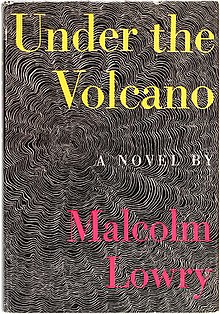Under the Volcano

First US edition
|
|
| Author | Malcolm Lowry |
|---|---|
| Country | United Kingdom |
| Publisher | Reynal & Hitchcock |
|
Publication date
|
1947 |
Under the Volcano is a novel by English writer Malcolm Lowry (1909–1957) published in 1947. The novel tells the story of Geoffrey Firmin, an alcoholic British consul in the small Mexican town of Quauhnahuac, on the Day of the Dead, 2 November 1938. The book takes its name from the two volcanoes that overshadow Quauhnahuac and the characters, Popocatepetl and Iztaccihuatl. Under the Volcano was Lowry's second and last complete novel.
The novel was adapted for radio on Studio One in 1947 but had gone out of print by the time Lowry died. Its popularity restored, in 1984 it served as the basis of a film of the same name. In 1998 the Modern Library ranked Under the Volcano at number 11 on its list of the 100 best English-language novels of the 20th century.
Lowry had already published one novel, Ultramarine (1933), by the time he was working on Under the Volcano, and in 1936 wrote a short story called "Under the Volcano" containing the kernel of the future novel. That story was not published until the 1960s; passages of it are found also in the account of Sigbjorn Wilderness, found in Dark as the Grave Wherein my Friend Is Laid, edited by Margerie Bonner (Lowry's second wife) and published in 1968. It contains what Conrad Aiken would later call "the horse theme," so important in Under the Volcano. The story includes the horse branded with the number seven, the dying Indian encountered while on a bus trip, the pelado who steals the Indian's money to pay his bus fare, and the inability of the spectator (Wilderness in the short story, the Consul in the novel) to act. All this ended up in the novel's eighth chapter.
The first version of the novel was developed while Lowry lived in Mexico, frequently drunk and out of control while his first marriage was breaking up. In 1940, Lowry hired an agent, Harold Matson, to find a publisher for the manuscript but found nothing but rejection—this manuscript is referred to by scholars as the 1940 version, and differs in details of various significance from the published version. Between 1940 and 1944, Lowry revised the novel (with significant editorial assistance from Margerie Bonner), a process which occupied him completely: during those years Lowry, who had been wont to work on many projects at the same time, worked on nothing but the manuscript, a process documented exhaustively by Frederick Asals. One of the most significant changes involved Yvonne's character: in earlier versions she was the Consul's daughter. By 1940, she was his unfaithful wife, and in that version (and a 1941 revision) chapter 11 ended with her and Hugh making love. A drastic rewriting in 1944 changed her ending and that of the novel: Yvonne dies at the end of the chapter, run over by the riderless horse released by the Consul in Parian, an event related in chapter 12.
...
Wikipedia
